Photosynthesis In Higher Plants Introduction
All organisms on earth require the input of energy from their environment. We know that the sun is the source of all energy. Only green plants can harvest and transduce solar energy into chemical energy. That is why they are known as autotrophic (Greek word autos meaning ‘self’ and trophy meaning ‘nourishing’) organisms. Light from the sun is transformed into chemical energy contained in organic material by the process of photosynthesis.
C.R. Barnes (1893) coined the term ‘photosynthesis’. This term is derived from two Greek words—photos meaning ‘light’ and synthesis meaning ‘formation’. Therefore, photosynthesis is the formation of compounds using light energy.
Photosynthesis In Higher Plants Definition: The physiological process, by which green plants synthesise carbohydrates, with the absorption of radiant energy of the sun and using CO2 and water as raw materials, is called photosynthesis.
“photosynthesis in higher plants notes for class 11”
Chemical reaction of photosynthesis: During photosynthesis, light energy splits water into oxygen and hydrogen, the latter is bound as NADPH (nicotinamide adenine dinucleotide phosphate, a coenzyme). This particular process termed the light reaction, takes place in the photosynthetic reaction centres embedded in thylakoid membranes of chloroplasts.
| Class 11 Biology | Class 11 Chemistry |
| Class 11 Chemistry | Class 11 Physics |
| Class 11 Biology MCQs | Class 11 Physics MCQs |
| Class 11 Biology | Class 11 Physics Notes |
It involves the transport of electrons, which is coupled with the synthesis of ATP. The compounds NADPH and ATP produced in the light reactions are called reducing power. These are consumed in the subsequent phase of photosynthesis, called the dark reaction (Calvin cycle). In this phase, carbohydrates are synthesised from CO2.
Photosynthesis is an anabolic process. In this process, carbon is assimilated by a redox reaction (simultaneous reduction and oxidation). This requires an- electron. carrier as well as energy. The electron carrier itself gets oxidised, reducing carbon dioxide to oxygen. Energy is obtained from sunlight. The overall chemical equation of photosynthesis (oxygenic) in green plants is
⇒ \(\mathrm{CO}_2+\mathrm{H}_2 \mathrm{O} \underset{\text { light }}{\stackrel{\text { Chlorophyll }}{\longrightarrow}}\left(\mathrm{CH}_2 \mathrm{O}\right)_n+\mathrm{O}_2\)
[(CH2O)n is a carbohydrate]
The general equation of photosynthesis is
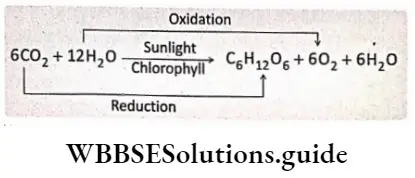
photosynthesis in plants class 11
Photosynthesis In Higher Plants Explanation of the chemical reaction: During photosynthesis, 6 molecules of carbon dioxide and 12 molecules of water react to produce 1 molecule of carbohydrate (glucose), 6 molecules of oxygen and 6 molecules of water. Hence, it is an anabolic process. Number of molecules of carbon dioxide consumed and that of oxygen produced is the same.
It is called a photochemical reaction as it occurs in the presence of light (photo) and chlorophyll (chemical). Oxidation of water produces oxygen and reduction of carbon dioxide produces glucose. Hence, it is a redox reaction. The volume of water produced is half of that consumed during the process.
Oxygenic Photosynthesis
The type of photosynthesis in which solar energy is captured and converted to ATP with the production of oxygen is called oxygenic photosynthesis. Water is used as an electron donor in this process. Green algae, green plants, blue-green algae and Euglena and Chrysoamoeba are oxygenic photosynthetic organisms.
“detailed notes on photosynthesis in higher plants”
Anoxygenic Photosynthesis
The type of photosynthesis in which some bacteria trap the solar energy to synthesise glucose without the release of oxygen is known as anoxygenic photosynthesis. Reduced inorganic molecules such as H2S, are used as electron donors in this process.
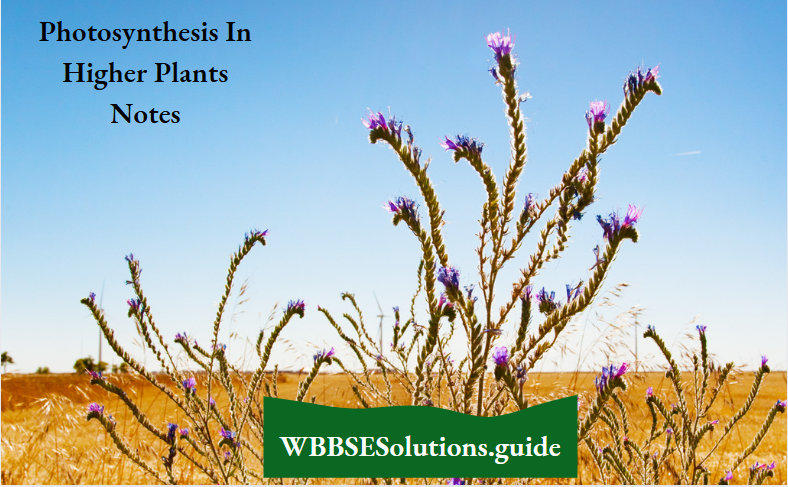
Photosynthesis or carbon assimilation: Photosynthesis is also known as carbon assimilation because the carbon molecule of CO2 in the air is assimilated to form an organic component of the cell. Autotrophs i.e., organisms who make their own food, perform carbon assimilation either through photosynthesis or through chemosynthesis. Photosynthetic organisms are also known as photoautotrophs. Chemosynthesis is carried out by the chemoautotrophs such as purple sulfur bacteria, methane bacteria, etc.
Photosynthesis Importance: Photosynthesis is one of the most important physiological processes in the living world.
“photosynthesis in higher plants handwritten notes”
This is because of the following reasons—
- Photosynthesis is the only known mechanism for synthesising organic materials from inorganic raw materials found in the environment. Photosynthetic organisms or producers are able to synthesise organic materials or food on which all other organisms or consumers depend directly or indirectly.
- It changes solar energy into chemical energy. This energy gets stored in the organic food as bonds between atoms. This energy is liberated when the bonds are broken during respiration.
- Numerous products such as firewood, timber, oils, gums, resins, rubber, cork, tannins, alkaloids, drugs, fibres, etc., are produced by the process of photosynthesis.
- Organic matter formed by the process of photosynthesis is the source of coal, natural gas and petroleum.
- Photosynthesis keeps the amount of CO2 under control. Carbon dioxide is added to the environment due to combustion and respiration. Plants regularly absorb CO2 during photosynthesis. Therefore, planting more trees is one of the solutions to check the rising amount of atmospheric CO2.
- The maximum percentage of atmospheric O2 has originated through photosynthetic activity.
Early Experiments Regarding Photosynthesis
Photosynthesis has always been an important aspect of plant physiological research. Several discoveries have paved the way for new insights into the process of photosynthesis.
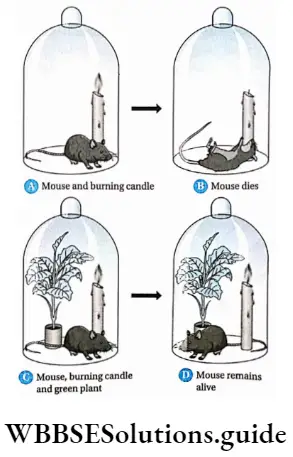
- In 1772, Joseph Priestley, a British scientist, showed plant shoots could purify ‘foul air’ produced by the burning of a candle. He observed that a burning candle when placed in a sealed chamber, gets extinguished. If a mouse is placed in this sealed chamber, it dies. However, if a plant is placed within the sealed chamber, along with a mouse, then the remains alive. This proved that plants could produce something (oxygen) that purified the air.
- In 1779, Jan Ingenhousz demonstrated that light is required by plants to produce oxygen.
- In 1782, Jean Senebier showed that green plants need to absorb carbon dioxide before they release oxygen. In fact, the rate of oxygen evolution is dependent on the rate of carbon dioxide consumed.
- In 1783, Antoine-Laurent Lavoisier, identified the dephlogiston (pure air) and phlogiston (impure or foul air) in Priestley’s experiment as oxygen and carbon dioxide, respectively.
- In 1804, Nicolas-Theodore de Saussure, a Swiss chemist and plant physiologist, showed that water is required for photosynthesis.
- In 1818, Pierre-Joseph Pelletier and Joseph-Bienaime Caventou, both French chemists, isolated and named chlorophyll, the green pigment required during photosynthesis.
- In 1845, Julius Robert von Mayer, a German physician and physicist, proposed that photosynthetic organisms convert light energy into chemical energy.
- In 1862, Julius von Sachs discovered starch as the
product of photosynthesis. - In 1882, Engelmann discovered that chloroplast, containing chlorophyll, is involved in photosynthesis. He also discovered the role of different wavelengths of light in photosynthesis. Thereby, he plotted the action spectrum.
- In 1905, Blackman discovered light and dark reactions in photosynthesis. He further proposed the ‘law of limiting factors’.
- In 1931, Cornelius van Niel demonstrated that some bacteria use H2S instead of H2O in photosynthesis.
⇒ \(\mathrm{CO}_2+\mathrm{H}_2 \mathrm{~S} \stackrel{\text { Light }}{\longrightarrow}\left[\mathrm{CH}_2 \mathrm{O}\right]_n+\mathrm{O}_2+2 \mathrm{~S}\) - In 1937, Robert Hill performed experiments and demonstrated that photooxidation of water is the main function of chloroplasts.
- In 1954, Melvin Calvin performed experiments on Chlorella and demonstrated the Calvin cycle.
Raw Materials Of Photosynthesis
The important components of photosynthesis are sunlight, chlorophyll, water and carbon dioxide. Among these, water and carbon dioxide are raw materials, while the presence of sunlight and chlorophyll is important for the process.
Experiments Proving Of Importance Of Essential Components Of Photosynthesis
Some simple experiments are described in this section which demonstrate the importance of the raw materials of photosynthesis in the process.
“photosynthesis in higher plants NEET notes”
Experiment to show the importance of chlorophyll in photosynthesis
- A variegated (with patches of green and non-green) leaf is plucked from the potted plant. The green patches contain chlorophyll, while the non-green patches do not contain chlorophyll.
- The leaf is boiled in a water bath for about 2-3 min and then placed in ethanol for 10 min. This destroys the chlorophyll present in the green parts of the leaf.
- The same leaf is now placed in boiling water for some time to remove the leftover chlorophyll.
- Now the leaf is placed in a petri dish and iodine solution is poured over it and observed.
- The parts of the leaf that were green initially, turned blue-black in colour. On the other hand, the non-green parts of the leaf remained brown.
- This happens because the green parts of the leaf contain chlorophyll. Starch is produced in those parts as a result of photosynthesis. This starch turned blue-black on reaction with iodine.
- The non-green parts of the leaf did not contain chlorophyll. Starch was not produced there. Due to the absence of starch, the iodine did not show any colour change. This experiment shows chlorophyll is essential for photosynthesis.
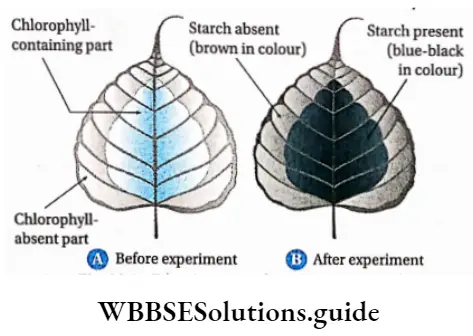
Experiment to show the importance of light in photosynthesis
- The potted plant is detached by keeping the plant in darkness for 48 hours. An iodine test is performed to ensure the plant has been detached.
- A leaf, from the same plant, is covered with black paper or Ganong’s light screen. Vaseline is applied to the junction of the leaf and the covering. This makes the arrangement air-tight.
- This plant is now allowed to remain under sunlight for about 24 hours.
- After 24 hours, the leaf is plucked and boiled in alcohol for some time, so as to remove the chlorophyll. The whole leaf now becomes pale.
- Iodine solution is now added to the leaf and observed.
- The uncovered parts of the leaf turn blue-black while the parts of the leaf that were covered with the light screen, remain brown in colour.
- The uncovered parts of the leaf received sunlight and hence could carry out photosynthesis. Starch was produced and as a result, a blue-black colour change was observed.
- On the other hand, the parts of the leaf that are covered with the light screen did not receive any sunlight. Hence, photosynthesis did not occur and starch was not produced. Thus, these parts did not show any colour change. This experiment proves that sunlight is essential for photosynthesis.
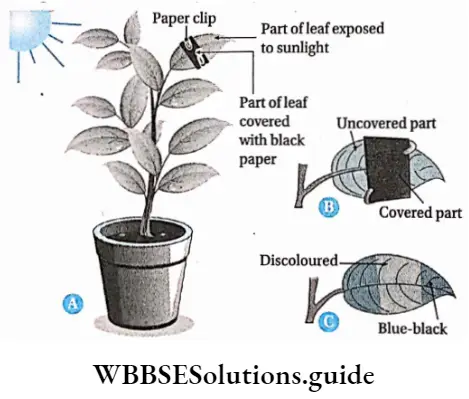
Ganong’s light screen
The broad, metallic plates used to cover the leaves of plants during experiments are known as Ganong’s light screen. It has a star-shaped pore at its centre. Light can enter only through this pore. When iodine solution is added over the leaf, only the star-shaped part and the uncovered parts of the leaf appear blue-black. The part of the leaf, that remains covered, appears pale.
Moll’s half-leaf experiment to show the importance of CO2 in photosynthesis
- The plant has been detached by keeping it in darkness for 48 hours.
- A 250 cc conical flask, containing 20% KOH solution, has been attached to the clamp. Its mouth has been covered with cotton soaked in lime water.
- A leaf of the detached plant is slid into this flask, through the lime water-soaked cotton. It must be ensured that the leaf remains freely suspended within the flask.
- 20% KOH solution absorbs the carbon dioxide within the flask. The mouth of the flask is plugged with a cotton plug soaked in lime. The mouth of the flask is made airtight with vaseline. This ensures a CO2-free environment for the leaf.
- This plant is kept in sunlight for about a day.
- After one day, this leaf is plucked from the plant and tested with iodine solution for the presence of starch.
- Another leaf of the plant is also plucked and tested for the presence of starch. This leaf acts as the control.
- The leaf that was placed in the conical flask, turned brown on adding iodine solution. On the other hand, the other leaf (control) showed a blue-black colour on adding iodine solution.
- The leaf that was placed in the flask, did not receive any carbon dioxide. Hence it was unable to photosynthesise and hence no starch was produced. Therefore no colour change was shown.
- On the other hand, the other leaf received CO2 from the environment. It was able to photosynthesise and produce starch. Hence, it showed the blue-black colour change.
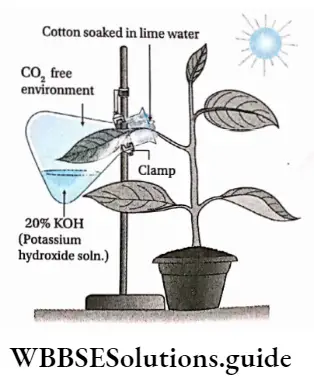
Site Of Photosynthesis
In higher plants, photosynthesis mainly takes place in leaves. However, other green parts of plants like young green stems, stalks and calyx of flowers also take part in photosynthesis.
Conditions That Make Leaf The Ideal Site For Photosynthesis
Leaves are ideal sites for photosynthesis because—
- The distended flat leaf blade is morphologically favourable for the absorption of sunlight and CO2.
- Phyllotaxy or the arrangement of leaves on the stem allows the leaves to receive the maximum amount of sunlight.
- Leaves bear stomata on the surface (either only on the lower surface or on both surfaces). It makes it easier to exchange gases with the atmosphere.
- Large intercellular spaces present between mesophyll cells help in efficient gaseous diffusion.
- An extensive network of veins and veinlets allows easy transport of water, nutrients and synthesized carbohydrates between leaves and other parts of the plant body.
Mesophyll Tissue
The tissue that is made up of chlorophyllous cells, present between the upper and lower epidermis, that helps in photosynthesis is called mesophyll tissue. In
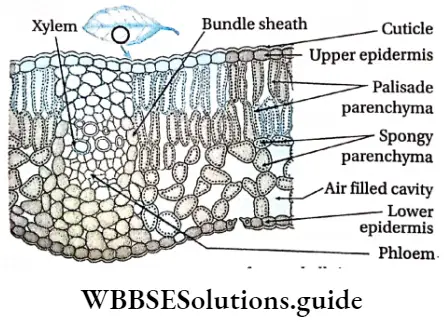
dorsiventral leaves, two types of cells—palisade parenchyma and spongy parenchyma, constitute this layer. Isobilateral leaves have only spongy parenchyma in this layer.
Chloroplast And Its Structure
Chloroplasts, found in mesophyll cells, are the main photosynthetic apparatus of plants. The chloroplast usually has a characteristic convex lens shape.
The major structural features of the chloroplast are described below—
- The chloroplast is surrounded by an envelope made up of two selectively permeable membranes. The membrane facing the cytoplasm is known as the outer membrane and the membrane present next to it is known as the inner membrane. The space enclosed within the double membrane is called the periplastidial site. These membranes help in the transport of metabolic substances between the chloroplast and cytoplasm.
- The proteinaceous matrix, enclosed by the inner membrane of the chloroplast is known as stroma. It contains the dissolved enzymes for CO2 fixation, protein synthesis, and storage of starch.
- The stacked structures present within the matrix, are called grana (singular: granum). A granum helps to trap the light energy. It is the part where the light reaction takes place. Each stack is composed of membrane-bound discs or sac-like structures called thylakoids. The space enclosed within the thylakoid membrane is called lumen.
- Thylakoid membrane contains chlorophylls, carotenoids, cytochromes (b and f), ATP-synthase, etc. These components help in the light reaction of photosynthesis.
- The grana are interconnected by hollow tube-like channels stretching across the stroma. These channels are called stroma lamellae. Chlorophyll molecules and other important components required for photosynthesis are present in the walls of the thylakoid.
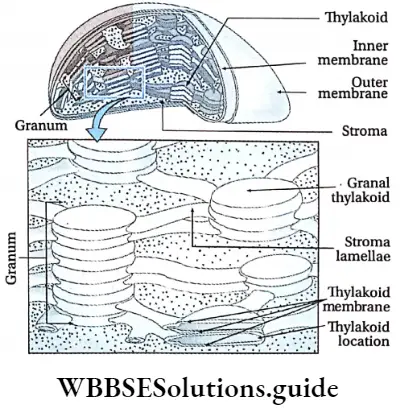
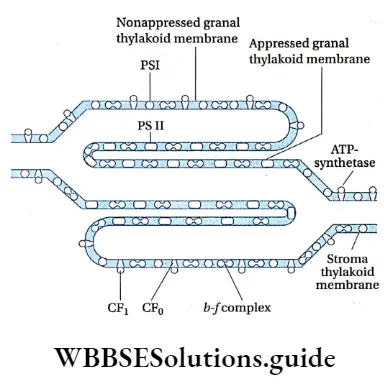
The whole process of photosynthesis is divided into different compartments of chloroplast.
Division of labour in chloroplast
The membranous system present within the chloroplast consists of grana, stroma lamellae, and fluid stroma. The membrane system creates compartments within the chloroplast where different activities can take place at the same time. Division of labour in the chloroplast is simple.
Absorption of light and all of the light reactions occur within or on thylakoid membranes. The process requires chlorophyll, which is present in grana. Chlorophyll entraps the photon molecules of sunlight within leaves.
“chapter-wise notes on photosynthesis in higher plants”
Hence, photophosphorylation (formation of ATP using light) occurs. The ATP and NADPH produced by these reactions are released into the surrounding stroma. The main reactions of photosynthesis, i.e., carbon assimilation and Calvin cycle, through which glucose is synthesised, take place during the light-independent phase i.e., through dark reactions. The enzymes and coenzymes required for the above processes are present in the stroma.
Other Photosynthetic Organisms And Their Parts
Besides higher plants, photosynthesis is also exhibited by other organisms
Lower plants
Blue-green algae and all chlorophyll-containing organisms (algae, moss, fern, gymnosperms and angiosperms), show photosynthesis.
Apart from leaves, some other parts of these plants that show photosynthesis are as follows
- Aerobic roots in orchids, carbon assimilating roots in Tinospora cordifolia (Gulancha), etc.
- Stems of cacti, pumpkin, gourd, etc.
Endosymbiotic theory
This theory postulates that several important organelles of eukaryotes originated as independent organisms that lived symbiotically within other single-celled organisms. In the 1960s, it was discovered that mitochondria and chloroplasts contain DNA and ribosomes.
Hence they could synthesise their proteins. According to this theory, mitochondria and chloroplasts were considered free-living bacteria, that must have entered another cell somehow and started living as an endosymbiont. This theory is known as endosymbiotic theory.
Photosynthetic unicellular Protista
Unicellular organisms and bacteria such as Euglena sp., Chrysamoeba sp., Rhodopseudomonas sp., Rhodospirillum sp., etc., show photosynthesis.
Pigments Involved In Photosythsis
Light may be reflected, transmitted or absorbed by matter. Compounds that absorb light are called pigments. Pigments that take part in photosynthesis are called photosynthetic pigments.
Pigments Involved In Photosynthesis Definition: The pigments, present within the living cells, that help to carry out photosynthesis and also provide colour to the fruits are called photosynthetic pigments.
Pigments Involved In Photosynthesis Location: They are generally present in the thylakoid and stroma lamellae of chloroplast.
Observation of difference in the rate of photosynthesis
- Between a distended and a wrinkled leaf: If the leaf blade is distended, mesophyll tissues within the leaf blade get the proper amount of sunlight. This sunlight reaches chloroplasts within mesophyll cells. The chlorophyll molecules in the chloroplasts become activated by sunlight.
On the other hand, the exposed surface area of a wrinkled leaf is much less. Hence the mesophyll tissues do not get sufficient sunlight and thereby, most of the chlorophyll molecules remain inactivate. Hence, the rate of photosynthesis is lesser in wrinkled leaves. - Between a simple pinnate leaf and a pinnately compound leaf: Since simple pinnate leaves are undivided, they do not have any segmented region. So, chloroplasts present throughout the leaf blade take part in photosynthesis. Hence, the rate of photosynthesis is higher. Segmented compound leaves have fewer chloroplasts. Thus, the rate of photosynthesis is less in the case of compound leaves.
Pigments Involved In Photosynthesis Types: Photosynthetic pigments are mainly of three types
- Chlorophyll,
- Carotenoids,
- Phycobilins.
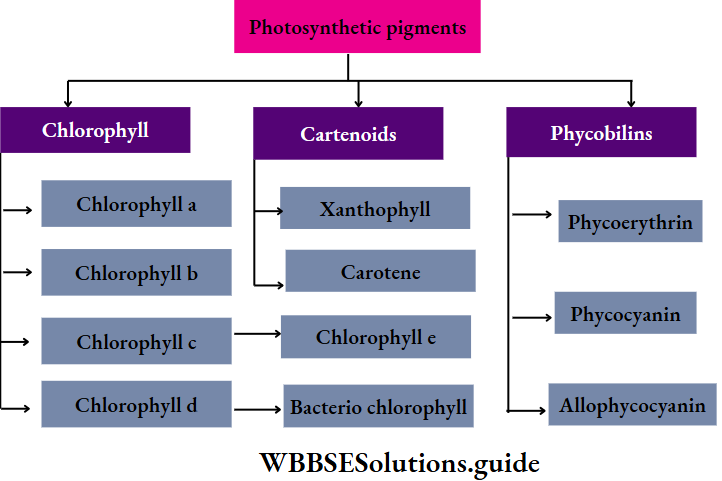
Chlorophyll is the primary photosynthetic pigment as it takes part in photosynthesis directly. Other photosynthetic pigments such as carotenoids and phycobilins do not directly take part in photosynthesis. Hence, they are called accessory photosynthetic pigments. Each type of pigment has been discussed under separate heads.
Relation Between Light Energy And Photosynthetic Pigments
The nature of light energy can be explained by certain theories.
Concept of light wave according to electromagnetic theory.
Most of the time light behaves like waves. Light waves are also known as electromagnetic waves, as they are made up of both electric and magnetic fields. Electromagnetic fields oscillate perpendicular to each other.
They also oscillate perpendicular to the direction of wave propagation, hence they are also known as transverse waves. The electromagnetic waves form a spectrum of different wavelengths ranging between 390-760 nm. This is visible to the human eye, hence, called the visible spectrum.
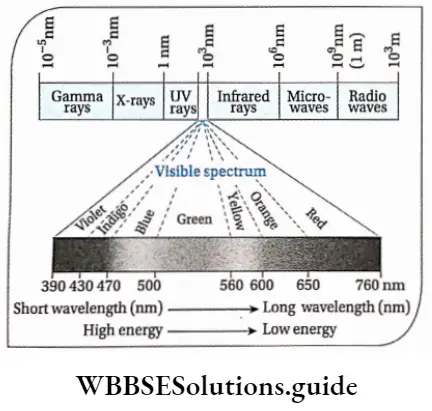
Photosynthetically Active Radiation (PAR):
Photosynthetically active radiation (PAR) is the visible spectrum ranging from 400 to 700 nm that photosynthetic organisms use for photosynthesis.
Photosynthetically Active Radiation Description: These are waves with shorter wavelengths and have a higher energy spectrum. Waves with longer wavelengths do not carry enough energy to allow photosynthesis. Hence, only waves of shorter wavelengths are used during photosynthesis.
Microorganisms, such as green bacteria, purple bacteria and Heliobacteria, use waves of relatively longer wavelength. These bacteria live at the bottom of stagnant ponds, sediment and ocean depths. Hence, they require such waves that can reach these regions.
Photosynthetically Active Radiation Absorption Spectrum: The part of the visible I spectrum, that is absorbed by specific pigments and used in photosynthesis is called absorption spectrum.
Photosynthetically Active Radiation Spectrum Formation: An absorption spectrum is obtained by allowing different wavelengths of visible light to pass through a solution of a pure compound. The amount of energy allowed to pass through the molecules of the solution for each wavelength is determined by a spectrophotometer.
The observations are plotted on a graph. The graphical representation of the absorption of light according to its wavelength, by the pigments, is called the absorption spectrum of that pigment. Absorption spectra are used by biologists to compare the wavelengths of light absorbed during photosynthesis by various plant pigments.
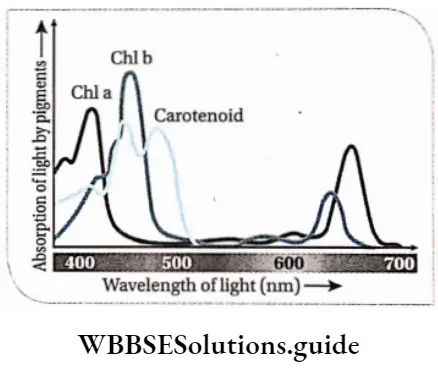
For example, Chlorophyll a has an absorption spectrum in the blue-violet region of the visible spectrum, while chlorophyll b has that in the red region of the visible spectrum.
Photosynthetically Active Radiation Action Spectrum: The part of the visible spectrum, comprising red (650-760nm) and blue-green (430-500nm) regions which is most effectively used during photosynthesis, is called the action spectrum.
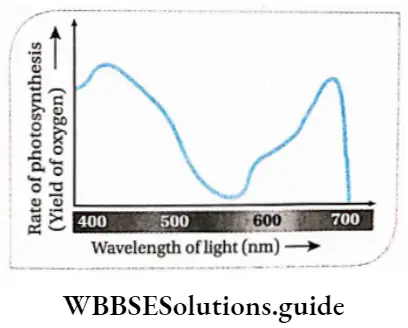
The comparative study of the rate of photosynthesis for different wavelengths of light gives us the action spectrum. It has been observed that the rate of photosynthesis is maximum for the blue-violet and red regions of the visible spectrum.
The action spectrum of light-dependent response resembles the absorption spectrum of a pigment complex that absorbs the effective light. A comparison of the action spectrum of photosynthesis with the absorption spectra of chlorophyll a indicates that the violet-blue and red region of the visible spectrum is most efficient for photosynthesis as well and chlorophyll a is the chief photosynthetic pigment.
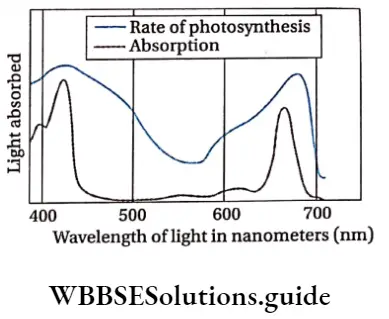
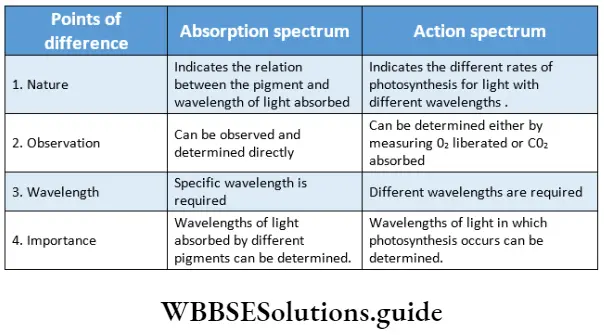
The concept of photon according to the Particle theory of Einstein
In 1905, Albert Einstein suggested that apart from being a wave light is also particulate in nature. He termed these tiny particles of light as photons. Each photon carries some amount of energy, though they are not equal in each photon. This energy is known as quantum. The energy content of a photon is dependent on the wavelength of light.
Quantum requirement: The number of photons required to produce 1 molecule of oxygen is called quantum requirement. According to Emerson, 8 photons are required to produce 1 molecule of oxygen.
Quantum yield: The ratio of molecules of oxygen released to that of photons absorbed is called quantum yield. The quantum yield of photosynthesis (<f>) is a measure of photosynthetic efficiency expressed in moles of photons absorbed per mole of CO2 absorbed or O2 evolved. It can be represented as
⇒ \(\phi=\frac{\text { Number of } \mathrm{O}_2 \text { molecules evolved }}{\text { Number of photons absorbed }}\)
⇒ \(\phi=\frac{\begin{array}{c} \text { Amount (moles) of reactant consumed } \\ \text { or product formed } \end{array}}{\text { Amount (moles) of photons absorbed }}\)
In photosynthesis, (f> ranges between 0.1 to 0.125, theoretically. This means that 8 mole of photons are required to produce 1 mole of O2 in the absence of photorespiration.
Red Drop And Emerson Enhancement Effect
In 1943, Robert Emerson and Charlton M. Lewis, demonstrated the efficiency of photosynthesis, in Chlorella sp., under different wavelengths of visible light. They observed a sudden, sharp decline of photosynthetic efficiency in the far-red region of the visible spectrum, that is, from 685 nm towards the infra-red region.
This phenomenon was known as the ‘Red Drop’. The cause of the sudden drop in the photosynthetic efficiency was unknown. However, it was observed that even at wavelengths above 685 nm, absorption of light by chlorophyll was still high.
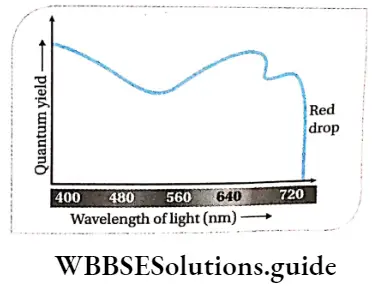
In 1955, Emerson and Ruth Chalmers came across an even stranger effect during another experiment. They observed that the ‘Red Drop’ disappeared if a supplementary light beam of a shorter wavelength was provided instead of infrared light.
They observed that the quantum yield obtained on passing infrared (700nm) and red-orange light (650nm) together, was more than that obtained on passing separately. This phenomenon is called the Emerson Enhancement Effect.
As a possible explanation, Emerson, Chalmers and Carl Cederstrand suggested that the supplementary light may have excited other pigments besides chlorophyll a. They proposed that this other pigment might be chlorophyll b, in Chlorella sp. This pigment may vary among different organisms.
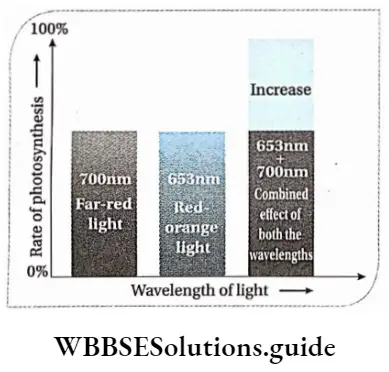
Emerson enhancement effect, (E), is expressed by the equation

Where AO2 represents the rate atO2 evolved.
Effect of absorption on pigment molecules
- When a chlorophyll molecule absorbs a photon, its electrons acquire energy. The electrons move from the ground (unexcited) state to the energised or singlet (excited) state. The energy difference between the ground state and the excited state determines the quanta of light absorbed.
- The excited state of an electron is unstable. In order to return to their ground state (attain stability), they release the energy in the form of heat or it is passed to the next electron.
- A part of the energy of the electron is released in such a way that the electrons come to an intermediate state between the ground and the excited state. This intermediate state is called the metastable triplet state.
- Electrons release energy by either fluorescence (electrons absorb light of a shorter wavelength but emit that of longer wavelength) or by phosphorescence (electrons absorb light of longer wavelength but emit that of shorter wavelength) to reach the ground state from this intermediate state.
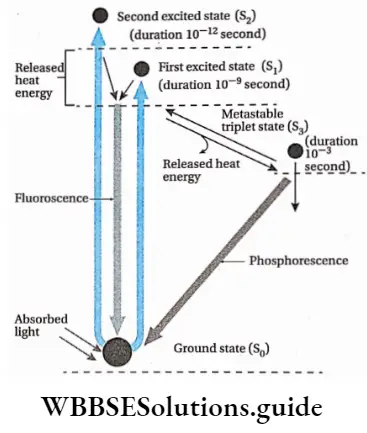
Light Harvesting Components Or Photosynthetic Units
the smallest group of pigment molecules working together in a photochemical process is called the photosynthetic unit. they take part in the absorption and transportation of a quantum of light to a reaction centre, thereby promoting the release of an electron.
They take part in the absorption and transportation of a quantum of light to a reaction centre, thereby promoting the release of an electron. each photosynthetic unit is made up of photosystem 1 (ps1), photosystem 2 (ps 2), cytochrome b6f complex and coupling factor or ATP synthase.
Each photosystem has a reaction centre or photo centre. a reaction centre consists of chlorophyll molecules. the reaction centre is run by two types of molecules—antenna molecules and electron molecules. chlorophyll a, chlorophyll b, carotenoids, phycobilins and protein molecules form an antenna complex.
“photosynthesis in higher plants notes with diagrams”
They absorb light energy get excited and push the electrons to their outer orbital. these antenna molecules pass over their energy to the electron carrier molecules. they again hand over the energy to the photo centre. generally, reaction centres in the photosystems have chlorophyll a dimer (P700 or P680).
Together with the antenna pigment molecules and electron carrier molecules, they form the light-harvesting centre (LHC). the different components of the antenna complex absorb different wavelengths of the spectrum. each pigment molecule transmits energy (photons) to the next pigment molecule. Finally, the energy reaches the chlorophyll a dimers and excites them.
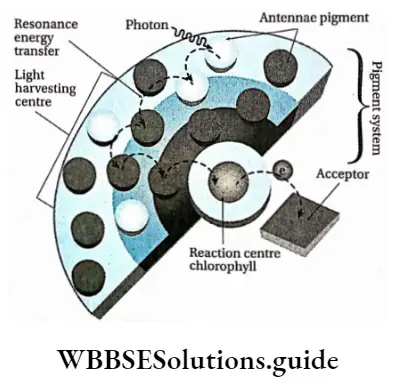
Points To Remember
- Photosynthesis is the process by which green plants synthesise food in the form of glucose, utilising CO2 and H2O from the atmosphere and releasing O2 as a byproduct.
- Leaves are the site of photosynthesis and chloroplasts are the cell organelles where the process is carried out.
- Photosynthetic pigments such as chlorophyll, carotenoids, xanthophylls, etc., are essential for trapping specific wavelengths of light.
- Only one type of photosystem is present in bacteria, that is similar to PS 1 in green plants and their photosynthetic pigments include bacteriochlorophyll, bacterioviridin, etc.
- When the thylakoids are arranged in stacks within the stroma or matrix of the chloroplast, they are called grana thylakoids.
- When the thylakoids remain as single units within the stroma or matrix of the chloroplast, they are called stroma thylakoids.
- The light rays are made up of particles called photons. Several photons form one quantum of energy.
- Quantum requirement is the number of quanta of energy required to release 1 molecule of oxygen, while quantum yield is the amount of oxygen released on utilising a quantum of energy.
“photosynthesis in higher plants important points”
- When the quantum yield decreases rapidly on being excited by light of monochromatic wavelength(above 680nm), the phenomenon is known as red drop. It was discovered by Emerson and Lewis.
- During photosynthesis, the violet-blue and red-coloured wavelengths of light get absorbed by the chlorophyll. When violet to blue wavelength (390-500nm) of light gets absorbed by the chlorophyll, the spectrum is known as the Soret band.
- Photosynthetically active radiation (PAR) implies light with a wavelength of 400-700nm.
- The electron carriers present in the electron transport chain that carry the electrons released by PS 1 and PS 2, are arranged in a zig-zag fashion called Z-scheme. The primary electron carriers include cytochrome, plastoquinone and plastocyanine.
- The process of photosynthesis includes two phases— the light phase and the dark or light-independent phase.
- The plants in which the 4C compound, oxaloacetic acid, is the first stable compound formed during the dark phase of photosynthesis are called C4 plants.
- These plants have a special arrangement of cells in their leaves, known as Kranz anatomy.
- There are several factors, both external and internal, that affect the rate of photosynthesis. The external factors include CO2 concentration, O2 concentration, water, temperature, etc. The internal factors include chlorophyll content, the internal structure of a leaf, etc.
